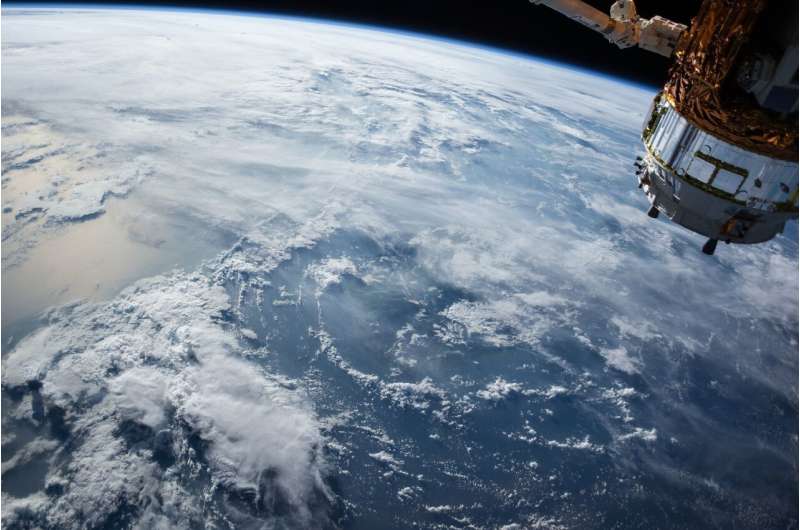This article has been reviewed according to Science X's editorial process and policies. Editors have highlighted the following attributes while ensuring the content's credibility:
fact-checked
reputable news agency
proofread
SpaceX shuttles science, holiday treats to astronauts Space Coast launch

SpaceX launched another rocket from Florida's Space Coast on Thursday night sending thousands of pounds of cargo to the International Space Station while also bringing back a booster that sent a sonic boom across Central Florida.
A Falcon 9 with an uncrewed cargo Dragon on the CRS-29 mission blasted off at 8:28 p.m. Eastern time from Kennedy Space Center's Launch Pad 39-A.
It was the second flight for the rocket's first-stage booster having back in August launched Crew-7, the crew of which are still on the ISS. Its recovery landing came not at seas, but back at Cape Canaveral Space Force Station Landing Zone 1, bringing the signature double sonic boom across parts of the Space Coast and Central Florida.
Orbiting the ISS are seven crew from the U.S., Japan, Denmark and Russia, and they'll get a fresh food kit including oranges, apples, cherry tomatoes and carrots as well as two specialty cheese kits.
"And because we're in the holiday season we've got some fun holiday treats for the crew like chocolate, pumpkin spice cappuccino, rice cakes, turkey, duck, quail, seafood, cranberry sauce and mochi," said Dana Weigel, NASA's deputy program manager for the International Space Station Program on Wednesday during a press conference to discuss the mission's Launch Readiness Review. "We've also got some pizza kits which are a favorite for our crew, some hummus, salsa and olives."
Among the 6,500 pounds of science and supplies headed to the International Space Station are major experiments to pave the way for deep-space communications NASA will need for its future crewed missions to Mars. Also on board is an Earth weather experiment to track atmospheric gravity waves and how it could affect Earth's climate.
The laser communication technology demonstration is called ILLUMA-T will use a terminal mounted on the exterior of the ISS to send infrared light to NASA's orbiting Laser Communications Relay Demonstration satellite, which will then beam it to ground stations in Haleakala, Hawaii and Table Mountain, California.
"This is using optical communication to use lower power and smaller hardware for sending data packages back from the space station to Earth that are even larger and faster than our capabilities today," said Meghan Everett, deputy chief scientist for the International Space Station Program Research Office.
"This optical communication could hugely benefit the research that we are already doing on the space station by allowing our scientists to see the data faster, turn results around faster and even help our medical community by sending down medical packets of data."
Laser-based communication is also being tested out on the recently launched Psyche probe as it heads out past Mars over the next several years.
The Earth science instrument flying up is NASA's Atmospheric Waves Experiment that will over two years look at the natural phenomenon that are small closer to the planet's surface, but can grow exponentially as they climb in altitude, and even venture into space, something not easily observable by scientists on Earth.
"So gravity waves you can think of them as little pockets of energy that start off very small, where they start and are in lower atmospheres. And they grow as they get into higher atmospheres, and here at the higher atmospheres because they're bigger we can measure them from the space station," Everett said.
"So we are hoping that by measuring these atmospheric, or these gravity waves, we can get a better idea of space weather which could impact climate change, or how winds in space affect our satellites."
Among the more than 3,330 pounds of science equipment for more than 50 experiments flying up are ones that aim to improve water filtration in both space and back on Earth, a female reproductive health investigation that will fly up 40 rodents, 20 of which will make their way back down to Earth before the others for comparative studies, and a study that looks at how fluid moves through the respiratory tract.
This cargo Dragon is also making its second flight having also visited the ISS for CRS-26 in 2022. It's slated to arrive around 5:20 a.m. Saturday docking autonomously to the space-facing port of the ISS Harmony module.
Dragon will spend about one month attached to the ISS before returning with about 3,800 pounds of cargo with a splashdown landing off the coast of Florida.
It marked the 62nd launch from the Space Coast among all companies in 2023, all but four of which have come from SpaceX. It's also the 81st launch from SpaceX among its Florida and California pads having also flown 23 missions from Vandenberg Space Force Base.
2023 Orlando Sentinel. Distributed by Tribune Content Agency, LLC.





















